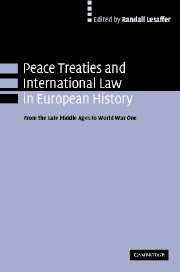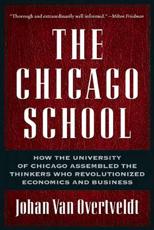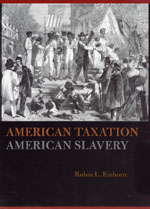The nineteen European university-based authors of the essays in this very useful

book use peace treaties as the lens through which to discern and systematize the long neglected history of what they call international legal practice, as opposed to doctrine and discourse (p. 1). These studies begin with the late fifteenth century, recognizing that the writings of the Spanish neo-scholastics in response to the age of discovery, the rise of great dynastic states, and the Reformation coalesced and formed the seed bed for the modern state system dominated by sovereign territorial nation states (p. 3). The studies, in turn, end with Versailles, because it “marked the turning point in the history of international law. Not only was it the first punitive peace between sovereigns since at least the late Middle Ages, thus dealing a blow to state sovereignty, but it also was the starting point for the era of international organizations. Moreover, during the twentieth century, peace treaties gradually lost their monopoly in the field of peace settlement.”(p.4).
After his introductory chapter, the editor of the book, Randall Lesaffer,addresses “the myth of Westphalia.” He argues that the basic principles it is usually associated with, sovereignty, religious neutrality, and a balance of power are not found in its treaties as principles of inter-state relations(p.9-10). He sees both remnants of medieval ways (e.g., the use of oaths as a method of notification) (p. 26) and new features portending fundamental change (e.g., the presence of amnesty clauses implying that the parties engaged in a mutually just war) (p. 38-39) in the treaty provisions. Further, Lesaffer considers the mid-seventeenth century as a period of “crisis” in the European legal order (p. 10) reducing the salience, if I may use that word here, of Westphalia.
Crisis or not, the next author, Heinz Duchhardt, looking at treaties before and after 1650 sees important changes in treaty practice. Earlier circumstances had reduced the unifying authority and arbitral role of both the Pope and the Emperor over the respublica Christiana, leaving a void in the international system. He argues it wasn’t until the Treaties of Utrecht (1713) that the construct of the balance of power was in place to fill those roles.
Heinhard Steiger completes part I by covering the period from the Treaty of Paris (1814) to the Treaties of Versailles (1919-20). He moves beyond a focus on the dominating power of what Grewe called the “English era,” to what he calls “the international law of civilized nations” by including the then colonial world in his purview (p. 66-67). He briefly discusses changes during that period in both the practice of negotiating treaties, including topics discussed & persons involved, and the internal structure of the treaties themselves.
A central assumption behind the book is that modern peace treaty practice drew on medieval thought and practice, which in turn looked back to antiquity. (p.4). Part 2 “Thinking Peace: Voices from the Past,” contains six essays that look in detail at how the Roman Law of treaties and the Canon Law operated, and in turn influenced early modern treaty practice. These pieces range from the very narrowly focused study of The Kiss of Peace by Hanna Vollrath to the wide ranging study of The Importance of Medieval Canon Law and the Scholastic Tradition for the Emergence of the Early Modern International Order by Dominique Bauer.
The authors all recognize the need for “many decades of systematic research” to answer all the questions that need to be answered about the history, thought,and influence of this period (p. 5). The unsettled state of this scholarship is illustrated by the different characterizations of Martinus Garatus Laudensis’ De Confederation, Pace et Conventionibus Principum, which is included as an appendix to this volume. Lesaffer calls it “the most comprehensive autonomous treatise on peace treaty law from the learned tradition of medieval ius commune.” (p. 5). The author of the essay on Garatus himself concludes rather,that it is merely “a variegated sample of late-medieval civil law and canon law authorities on a limited range of related issues…just loose fragments …” (p.196).
Part 3, “Thinking Peace: Towards a Better Future,” contains four essays, three of which are focused on particular international law theorists. One by Mark Belissa uses the work of Gabriel Bonnot de Mably to develop the enlightenment idea of bonne foi. A second by Mathias Schmoeckel discusses how Lassa Oppenheimer’s text International Law (1905) framed, for decades after their adoption, the general understanding of the Versailles treaties ending World War I and establishing the League of Nations.
The third essay, by Ingo Hueck doesn’t seem to fit with the overall theme of the book. It rather looks at the experience and thought of the late 19th and early 20th German academic international lawyers in order to answer the question “why indeed did the strongest maritime and colonial power, Britain,develop a strong notion of securing peace and building international relationships in the age of imperialism, while the young German Empire was devoting itself to glorifying war” (p. 295). The answer he gives, based in significant part on the role of German academics at the Hague Conferences of1899 and 1907, is that German nationalism tragically marginalized the thinking of other more liberal and pacifist academics.
In part 3, Andreas Osiander’s essay also “holds a somewhat peculiar place” (p.5). It is however, a most interesting attempt “to place the general subject matter of this volume, peace negotiations and treaties, within a theoretical framework” which critiques International Relations Realism for its universalistic, a historicist, and statist assumptions (p. 289). Osiander findspeace talks “among the most fruitful sources” of the discourse in which the widely shared assumptions of a time are manifest. These assumptions have the capacity in his view to “create durable social & political structures”which in turn influence the formation of future assumptions, and so on (p. 313).
Part 4, “Making Peace: Aspects of Treaty Practice,” has four essays which develop in some depth, unrelated but fundamental dimensions of early modern treaty law practice. Ronald Asch’s essay on ius foederis, the right to pursue a separate foreign policy, illustrates the ambiguity of this and so many other concepts used through several periods of history. Should this concept be understood in seventeenth-century terms as the then otherwise obsolete right of resistance or should it be understood as a precursor of the modern notion of self-determination (p. 337)? Karl- Heinz Ziegler reviews the history of treaties between European powers and the Ottoman Empire from the middle ages to the early 20th century. Neither Christians nor Moslems have ever been fully comfortable with trusting unbelievers. Ziegler’s chronicle like review and its footnotes can serve as a valuable bibliography for further research. Stephen Neff traces the history of what he refers to as the commercial aspects of peacemaking. This sketch, which is not concerned with either indemnities or reparations as such, has value, again like most of the other essays in this book, as a catalogue of experiences, in this case, with the economic components of peacemaking. Christian Tomuschat compares the treaties of 1870 – 71 and 1919-20, each ending a war between France and Germany. He argues that each was “embedded in widely divergent political & legal contexts” (p. 395). Heconcludes that the most salient difference was the introduction of “issues of international morality” (p. 395). This in a sense can be seen as a return to the pre-modern era of respublica Christiana when it was thought that only one party to a war could be acting justly.
The editor concludes this volume with the main results of the research as he sees it. First, Westphalia does not represent the great divide it is usually thought of as either for understanding the European state system, the law of nations, or treaty law (p. 404-408). Next, treaty law as an autonomous discipline emerged in the seventeenth century (p. 406). Third, the Reformation caused the Roman & Canon law basis for the respublica Christiana to crumble(p.405). Finally, in addition to treaties and international custom, modern practice retains elements of Roman & Canon Law (p. 409).
For the rest, click
here.
 ent equality was what the plaintiffs themselves had sought in Brown in the first place.
ent equality was what the plaintiffs themselves had sought in Brown in the first place.









